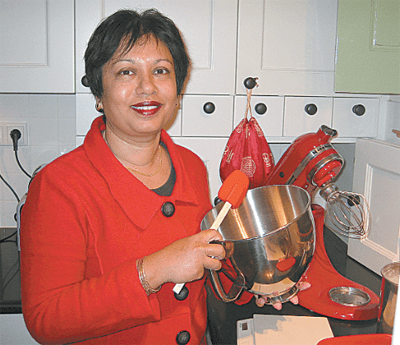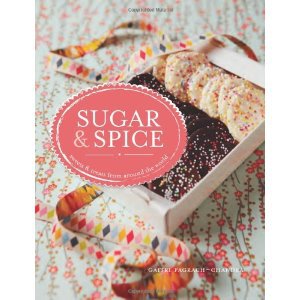

With Christmas right around the corner, it’s a delight to bring you Guyanese-born author Gaitri Pagrach-Chandra who serves up exquisite recipes in her cookbooks “Warm Breads and Honey Cakes: Home Baking from Around the World” and “Sugar and Spice: Sweets and Treats from Around the World”, and much more.
Gaitri is a food writer and historian. She currently resides in The Netherlands where she researches and writes about food and food traditions and culture. Gaitri grew up balancing the Caribbean influences of this South American land on one hand and the other, her Indian roots. She has won many awards for her cookbooks and essays on gastronomy and also writes in Dutch. Her latest book, Sugar and Spice which looks at desserts and sweets from around the world, was recently published and her Dutch book (Het Nederlands Bakboek) has been nominated for Cookbook of the Year in Holland.
Gaitri describes herself as “a convent-attending Guyanese Hindu of Indian ancestry, who was educated in North America and Europe and subsequently married into a European Jewish family”. She is also a freelance translator and has authored a book on Dutch baking – ‘Windmills in my Oven’ (Prospect Books, 2002). She received the Sophie Coe award for food history in 2000 for her paper, “Damra Bound: Indian Echos in Guyanese Foodways”, presented by the Oxford Symposium on Food and Cookery. Her book, Warm Bread and Honey Cake (Pavilion, 2010), won the Guild of Food Writers Award for Cookbook of the Year 2010.
In an interview with the T&T Guardian, Gaitri is quoted as saying “food is not just sustenance for the body. To me, it is a source of delight on all levels: deciding what to cook, shopping for the ingredients, preparing the dish, eating it—preferably in the company of like-minded people, so that we can talk about the food as we eat it.” And that’s not all. I enjoy thinking about the historical and cultural implications of food, too. Then comes the part I love most: writing about it. That’s how I came to write my first book, Windmills in my Oven. Several years later Warm Bread and Honey Cake (2009) followed. “
Giatri went on to say “that book—Sugar and Spice—covers a world of sweet bites, from fudges to brittles, brownies and tiny pastries. Even the lovely toolum from my childhood visits to Trinidad has not been forgotten. Blood will always tell, and what I particularly enjoyed doing were the Indian sweets, from laddus to barfi, gulab jamun, kalakand and more. Many of them took me straight back to my Guyanese childhood, especially festive occasions. Caribbean people use food as love and almost always make enough to share—especially when it’s something sweet. At Eid, our Muslim friends would bring over plates and dishes crowned to the brim with succulent sawine (vermicelli cake), rich and creamy barfi and chunky, cake-like “Muslim” mithai.
Gaitri’s cookbooks offer excellent recipes well-suited to the modern kitchen that will awaken your tired palates. Pick up a copy of at www.amazon.com, also check out her fan page www.facebook.com/gaitri.pagrach.chandra and website www.gaitripagrachchandra.com
Below is the recipe of Gaitri’s Drunken Apple Cake. Enjoy with moderation!

Ingredients
For the filling
- 1 1/2 pounds tart apples (about 5 medium-size apples)
- Generous 1/3 cup (2 3/4 ounces) granulated sugar
- 1/2 cup (3 1/2 ounces) heavy cream
For the cake
- 2 cups (10 1/2 ounces) all-purpose flour, plus more for the pan
- 2 1/2 teaspoons baking powder
- 1/4 teaspoon salt
- 11 tablespoons (5 1/2 ounces) unsalted butter, at room temperature, plus more for the pan
- Generous 1 cup (8 ounces) granulated sugar
- 3 eggs, lightly beaten
- 5 tablespoons rum (any rum will do quite nicely)
- 5 tablespoons cold water
Directions
Make the apple filling
- 1. Peel and core the apples. Cut each apple into 8 wedges and then cut each wedge lengthwise into slender slices.
- 2. In a bowl, combine the sugar and cream. Add the apples. Set aside until needed.
Make the batter
- 3. Preheat the oven to 325°F (160°C). Butter the pan and dust with flour.
- 4. Sift the flour with the baking powder and salt and set aside.
- 5. Beat the butter and sugar in a large bowl, either with an electric mixer or by hand, until smooth and creamy. Add the lightly beaten eggs to the butter mixture in 4 batches, scraping down the sides of the bowl and beating well after each addition. Gently fold in the flour in 4 batches, adding the rum and water with the third batch. Stop mixing as soon as the last batch of flour is incorporated.
- 6. Divide the batter into 3 portions. (You can eyeball it, but each portion should be about 1 cup or so.) Scrape 1/3 of the batter into the prepared pan and smooth the surface. Spoon half of the apple and cream mixture evenly over the batter, leaving a 1/2-inch plain border around the edge and smoothing the slices so they’re neat and level. Scrape another 1/3 of the batter on top of the apples and cream and smooth the surface, spreading the batter all the way to the edge of the pan. Spoon the remaining apples and cream evenly on top of the batter, and then top with the third and final batch of batter, smoothing it all the way to the edge of the pan, which will be quite full.
- 7. Bake the cake for 1 1/2 hours, or until a skewer inserted into the center of the cake comes out clean. Let cool in the pan for 15 to 20 minutes, then release the sides of the pan and transfer the cake to a wire rack to cool completely. Your drunken apple cake will keep at room temperature for up to 4 days.


